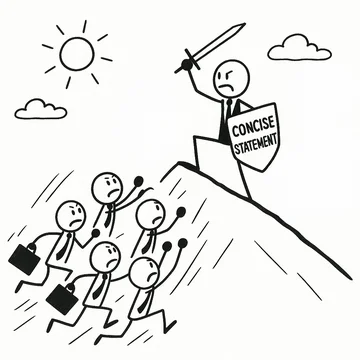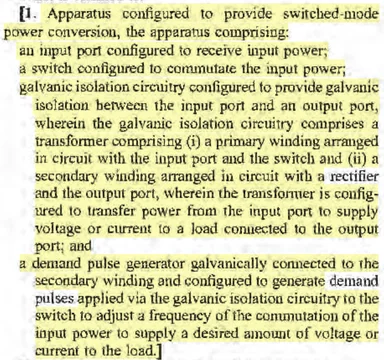
Last year we had a post entitled "Use This One Simple Trick to Not Get Your Summary Judgment Motion Instantly Denied." That post related to motions before judges who require a concise statement of facts with summary judgment motions. The "one simple trick" was that, rather than including a long list of atomic facts like "x said this at deposition" and "lines x:xx - y:yy of the patent specification say z," you state the actual material fact that you are relying on and cite those atomic facts as support for the broader fact.
Beyond that, your concise statement of facts should only include “material” facts. In other words, for each "fact" in your concise statement of facts, you should basically agree that you should lose the motion if there is a dispute as to that fact. (I say "basically" here because there can be multiple bases for a motion -- but consider whether those should be separate motions, as discussed below).
Here is the example we used in the last post. The wrong way (in my view) to do it is to include each atomic fact separately in the concise statement, like this:
1. Ms. Smith testified that she was employed by defendant in 2023. Ex. 1 at 2:3-4.
2. Defendant's employment agreement from Ms. Smith is dated 2023. Ex. 2 at 8.
3. Mr. Ford saw Ms. Smith in the office in 2023. Ex. 3 at 2.
In my opinion, that's not the right way to do it, because those facts aren't material. If there is a dispute as to one of them, you ought to still win the motion. Instead, include one material fact on each point, like this, with the individual facts listed as citations in support:
1. Ms. Smith was employed by defendant in 2023. See Ex. 1 at 2:3-4 (Ms. Smith testifying . . .); Ex. 2 at 8 (employment agreement dated 2023); Ex. 3 at 2 (Ford declaration stating Ms. Smith was in the office in 2023).
That way, the only way you should lose your motion is if there is a dispute as to the material fact you are relying on—here, that the person was employed in 2023—not some subsidiary fact that doesn't matter (e.g., whether someone saw the person in the office in 2023).
Since our original post last year, I've heard some pushback on this. Another school of thought is that the atomic facts are better, because they can be truly indisputable. For instance, in the example above, some might say that no one could ever dispute that "Ms. Smith testified that she was employed by defendant in 2023." They’d say that there is a transcript cite right there! And even if you disagree with the ultimate fact, the court can never disagree that it was said during a deposition, right? Plus, then we can omit the statement of facts from our brief, right?
No. I disagree. In my view, what most of the judges are trying to do here is have the parties list the actual material facts and support for the summary judgment motion in the concise statement. "X testified to y" is not usually the material fact you are relying on. Nor do I think the judges intended the concise statement of facts to be a place where parties just dump in their cut-and-pasted statement of facts that would otherwise have been in their brief, to save pages (a bad idea regardless, in my opinion).
Another Data Point—Motion Denied
Well, we got another data point on this last week, and to me it looks consistent with what we've been saying on the blog. In Magnolia Medical Technologies, Inc. v. Kurin, Inc., C.A. No. 24-1124-CFC (D. Del.), the accused infringer moved for summary judgment of no patent infringement.
They filed a single motion, and their brief included two separate arguments addressing two ranges of asserted claims. D.I. 253 at 1, D.I. 275 at 2-3.
They argued that the first set of claims require a "pressure differential" in a certain location, which their product lacks, and that the second set requires that the pressure differential "build," which theirs doesn't. D.I. 275 at 2-3.
They included no statement of facts whatsoever in their brief. They only cited to their concise statement of facts which, under the Court's scheduling order, must include only the facts absolutely necessary for the motion, and no others:
When preparing the separate concise statement, a party shall reference only the material facts that are absolutely necessary for the Court to determine the limited issues presented in the motion for summary judgment (and no others), and each reference shall contain a citation to a particular affidavit, deposition, or other document that supports the party's interpretation of the material fact.
Id., D.I. 102 at 23.
(Honestly, I don't know how anyone can disagree with our previous post in light of that language, which is pretty clear in my view. But here we are.)
The moving party’s concise statement of facts didn't follow the technique we've recommended. It's partially redacted, but as far as I can tell they didn't include a fact like "the accused products lack a pressure differential that builds. See x, y, z . . ." Id., D.I. 274. Instead, they included a long list of facts about who testified to what and when. Id. at 6-10. For example, they included this fact about what the opposing party's expert testified to, rather than what the reality is:
22. Dr. Meinhart testified that before the Jet’s stopper is dislodged, the pressure differential between 8 and 9 falls to zero. Id. at 240:4-240:15, 243:8-243:18, 230:4-230:15.
I can imagine how the discussion would go here between Delaware counsel and counsel who drafted the motion. I've had it quite a few times at this point:
Delaware counsel: "You can't just dump your statement of facts into the concise statement. You need to list each of your material facts, the citations that support them, and only the material facts."
Whoever is writing the brief: "No, you're wrong. If we do that, the Court might find a dispute. We will just include a fact about what the expert testified to. That's absolutely indisputable."
Well, as it turns out, using these little atomic facts in the concise statement is not enough to save the motion. The patentee responded by disputing the fact:
Disputed. Professor Meinhart did not testify that the pressure differential between 8 and 9 “falls to zero.” He testified, that “during Regime B . . . the pressure gradient [between 8 and 9] is negative, building to a value of zero.” Voronov Ex. E (Meinhart Deposition Tr.) at 236:10-237:22.
Id., D.I. 202 at 13.
The Court agreed, and denied the motion based on that single disputed fact, without otherwise reaching the merits:
In its concise statement of material undisputed facts filed in support of its motion, Kurin states that "Dr. Meinhart testified that before the Jet's stopper is dislodged, the pressure differential between 8 and 9 falls to zero." D.I. 254 , ¶ 22 (emphasis in the original). Magnolia disputes this asserted fact and states that Dr. Meinhart "testified, that 'during Regime B ... the pressure gradient [between 8 and 9] is negative, building to a value of zero." D.I. 293, ¶ 22 (alterations in the original and citation omitted). Magnolia cites record evidence that appears on its face to support its statement. See D.l. 295-5 at 236:10-237:22.
Because there is a disputed fact that Kurin has said is material to its motion for summary judgment, I will deny the motion.
Magnolia Medical Technologies, Inc. v. Kurin, Inc., C.A. No. 24-1124-CFC, D.I. 340 (D. Del. Sept. 18, 2025).
Because the moving party had included that allegation as its own independent material fact, it was easy for the Court to deny the motion when it found a pretty obvious dispute about that fact—even if the various other facts on this point might have outweighed it.
If They Had Done It Right, Would It Have Saved Their Motion?
It's impossible to say. It could be that the Court eliminated their motion quickly, seeing an obvious dispute on a fact that the party themselves had indicated, by including it in their concise statement, was "absolutely necessary" to their motion. In that case, the moving party would definitely have been better off doing it the right way (at least, IPDE's interpretation of the right way).
On the other hand, it could be that the Court dug in to the briefing, spent days or weeks carefully analyzing it, and found an actual dispute about the underlying fact of whether the pressure "builds" in light of the various facts they set forth, and just framed it as a dispute about that one fact. In that case, the outcome may have been no different.
Either way, though, I think the moving party would have been better off following the Court's own guidance in the scheduling order. If they had framed the fact as whether the pressure builds, rather than what an expert said in a single deposition, the Court would have needed to weigh the totality of the evidence on that point before denying the motion. It may have turned out that, as the Court dug in, it found there really was no dispute on the ultimate fact in light of the other evidence cited, and that the motion would have been granted. We'll never know.
The Court Didn't Reach the Other Half of Their Argument, Which Didn't Involve This Fact
Another interesting point here is that the Court didn't reach the first half of the summary judgment argument, which had nothing to do with this fact.
As I mentioned above, the accused infringer moved for SJ on two sets of claims. Only the second set involved the "build" limitation. But they filed only a single SJ motion and a single concise statement, and in doing so they implied that what the expert testified to was "absolutely necessary" to their motion—even though, as far as I can tell, it was actually irrelevant to their primary argument as to the first set of claims.
With the benefit of hindsight, the better way to have structured this might have been to do it as two separate motions:
- Motion 1: Claims x-y are invalid because they lack a "pressure differential" at the claimed location.
- COS 1: (1) the claims require a "pressure differential" at x location, see citations; (2) the accused products lack a "pressure differential" at x location, see citations
- Motion 2: Claims y-z are invalid because the pressure differential does not "build"
- COS 2: (1) the claims require that the pressure differential "build," see citations; (2) the accused products lack a pressure differential that "builds," see citations.
That way, at least, they could have influenced which motion the Court addressed first (using its ranking procedures), and avoided the possibility of a dispute of fact as to motion 2 resulting in a denial of motion 1.
If you enjoyed this post, consider subscribing to receive free e-mail updates about new posts.



